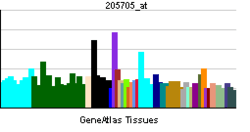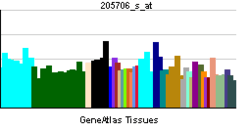ANKRD26
| ANKRD26 | ||||||
|---|---|---|---|---|---|---|
| Identifiers | ||||||
| Aliases | ANKRD26, THC2, bA145E8.1, ankyrin repeat domain 26 | |||||
| External IDs | MGI: 1917887 HomoloGene: 45968 GeneCards: ANKRD26 | |||||
| RNA expression pattern | ||||||
  | ||||||
| More reference expression data | ||||||
| Orthologs | ||||||
| Species | Human | Mouse | ||||
| Entrez | ||||||
| Ensembl | ||||||
| UniProt | ||||||
| RefSeq (mRNA) | ||||||
| RefSeq (protein) |
| |||||
| Location (UCSC) | Chr 10: 26.99 – 27.1 Mb | Chr 6: 118.5 – 118.56 Mb | ||||
| PubMed search | [1] | [2] | ||||
| Wikidata | ||||||
| View/Edit Human | View/Edit Mouse |
Ankyrin repeat domain-containing protein 26 is a protein that in humans is encoded by the ANKRD26 gene.[3][4] This protein has a function that is not currently understood.
Ankyrin repeat domain-containing protein 26 is a protein that in humans is encoded by the ANKRD26 gene.[5]
Gene
ANKRD26 is found on chromosome 10, at 10q21. It has 6816 base pairs in the reference sequence mRNA transcript.[6]
Neighborhood[7]
LOC100289548 (PUTAETIVE UNCHARACTERIZED PROTEIN C10ORF52-LIKE) is located directly to the left (3') of ANKRD26, and is a protein coding gene located at 10p12.1.[7] It has an unknown function. On the other side of LOC100289548 is NCRNA00202 non-protein coding RNA 202.[8] On the 5' end of ANKRD26, YME1L1 can be found at 10q14.1. The protein encoded by the YME1-like 1 is an ortholog of yeast mitochondrial AAAmetalloprotease.[9] This gene is thought to play a role in mitochondrial protein metabolism.[9] On the positive strand of human chromosome ten, located next to the 5' end of ANKRD26 is MASTL, microtubule associated serine/threonine kinase-like. This particular gene encodes the microtubule associated serine/threonine kinase.1 Mutations within these gene have been expected to be associated with thrombocytopenia-2.[10]
Protein [11]
Ankyrin repeat domain-containing protein 26 has three conserved domains: ANK, SbcC, and DUF3496. ANK conserved domain is located from amino acid 74-199. Ankyrin repeats are found to mediate protein-protein interactions, and also contains two antiparallel helices, as well as a beta-hairpin. SbcC conserved domain can be found from amino acid 743-1333, and is domain associated with ATPase involved in DNA repair. There is also a domain of unknown function from amino acid 1538-1649.
Expression[12]
In humans ANKRD26 was seen to be most highly expressed in the ear, lymph, esophagus, parathyroid, and placenta, as well as, most commonly seen in esophageal tumors and lymphoma, as well as seen in the blastocyst, fetus, juvenile, and adult developmental stages. In humans this is associated at all stages of life with lymphoma cancer as well as esophageal tumors. The association with expression in tissues and disease states doesn't show enough difference to link one another.[12]
References
- ↑ "Human PubMed Reference:".
- ↑ "Mouse PubMed Reference:".
- ↑ Kikuno R, Nagase T, Ishikawa K, Hirosawa M, Miyajima N, Tanaka A, Kotani H, Nomura N, Ohara O (Oct 1999). "Prediction of the coding sequences of unidentified human genes. XIV. The complete sequences of 100 new cDNA clones from brain which code for large proteins in vitro". DNA Res. 6 (3): 197–205. doi:10.1093/dnares/6.3.197. PMID 10470851.
- ↑ "Entrez Gene: ANKRD26 ankyrin repeat domain 26".
- ↑ Entrez Gene: ANKRD26 ankyrin repeat domain 26
- ↑ "Homo sapiens ankyrin repeat domain 26 (ANKRD26),mRNA". National Center for Biotechnology Information. Retrieved 5.2.11. Check date values in:
|access-date=(help) - 1 2 "Gene". National Center for Biotechnology Information.
- ↑ "NCRNA00202 non-protein coding RNA 202 [ Homo sapiens ]". National Center for Biotechnology Information. Retrieved 5.2.11. Check date values in:
|access-date=(help) - 1 2 "YME1L1 YME1-like 1 (S. cerevisiae) [ Homo sapiens". National Center for Biotechnology Information. Retrieved 5.3.11. Check date values in:
|access-date=(help) - ↑ "MASTL microtubule associated serine/threonine kinase-like [ Homo sapien". National Center for Biotechnology Information. Retrieved 5.3.11. Check date values in:
|access-date=(help) - ↑ "Conserved Domains". National Center for Biotechnology Information. Retrieved 5.2.11. Check date values in:
|access-date=(help) - 1 2 "EST Profile". National Center of Biotechnology Information. Retrieved 4.20.11. Check date values in:
|access-date=(help)
Further reading
- Olsen JV, Blagoev B, Gnad F, et al. (2006). "Global, in vivo, and site-specific phosphorylation dynamics in signaling networks.". Cell. 127 (3): 635–48. doi:10.1016/j.cell.2006.09.026. PMID 17081983.
- Kimura K, Wakamatsu A, Suzuki Y, et al. (2006). "Diversification of transcriptional modulation: large-scale identification and characterization of putative alternative promoters of human genes.". Genome Res. 16 (1): 55–65. doi:10.1101/gr.4039406. PMC 1356129
 . PMID 16344560.
. PMID 16344560. - Gerhard DS, Wagner L, Feingold EA, et al. (2004). "The status, quality, and expansion of the NIH full-length cDNA project: the Mammalian Gene Collection (MGC).". Genome Res. 14 (10B): 2121–7. doi:10.1101/gr.2596504. PMC 528928
 . PMID 15489334.
. PMID 15489334. - Fu GK, Wang JT, Yang J, et al. (2005). "Circular rapid amplification of cDNA ends for high-throughput extension cloning of partial genes.". Genomics. 84 (1): 205–10. doi:10.1016/j.ygeno.2004.01.011. PMID 15203218.
- Deloukas P, Earthrowl ME, Grafham DV, et al. (2004). "The DNA sequence and comparative analysis of human chromosome 10.". Nature. 429 (6990): 375–81. doi:10.1038/nature02462. PMID 15164054.
- Ota T, Suzuki Y, Nishikawa T, et al. (2004). "Complete sequencing and characterization of 21,243 full-length human cDNAs.". Nat. Genet. 36 (1): 40–5. doi:10.1038/ng1285. PMID 14702039.
- Strausberg RL, Feingold EA, Grouse LH, et al. (2003). "Generation and initial analysis of more than 15,000 full-length human and mouse cDNA sequences.". Proc. Natl. Acad. Sci. U.S.A. 99 (26): 16899–903. doi:10.1073/pnas.242603899. PMC 139241
 . PMID 12477932.
. PMID 12477932.